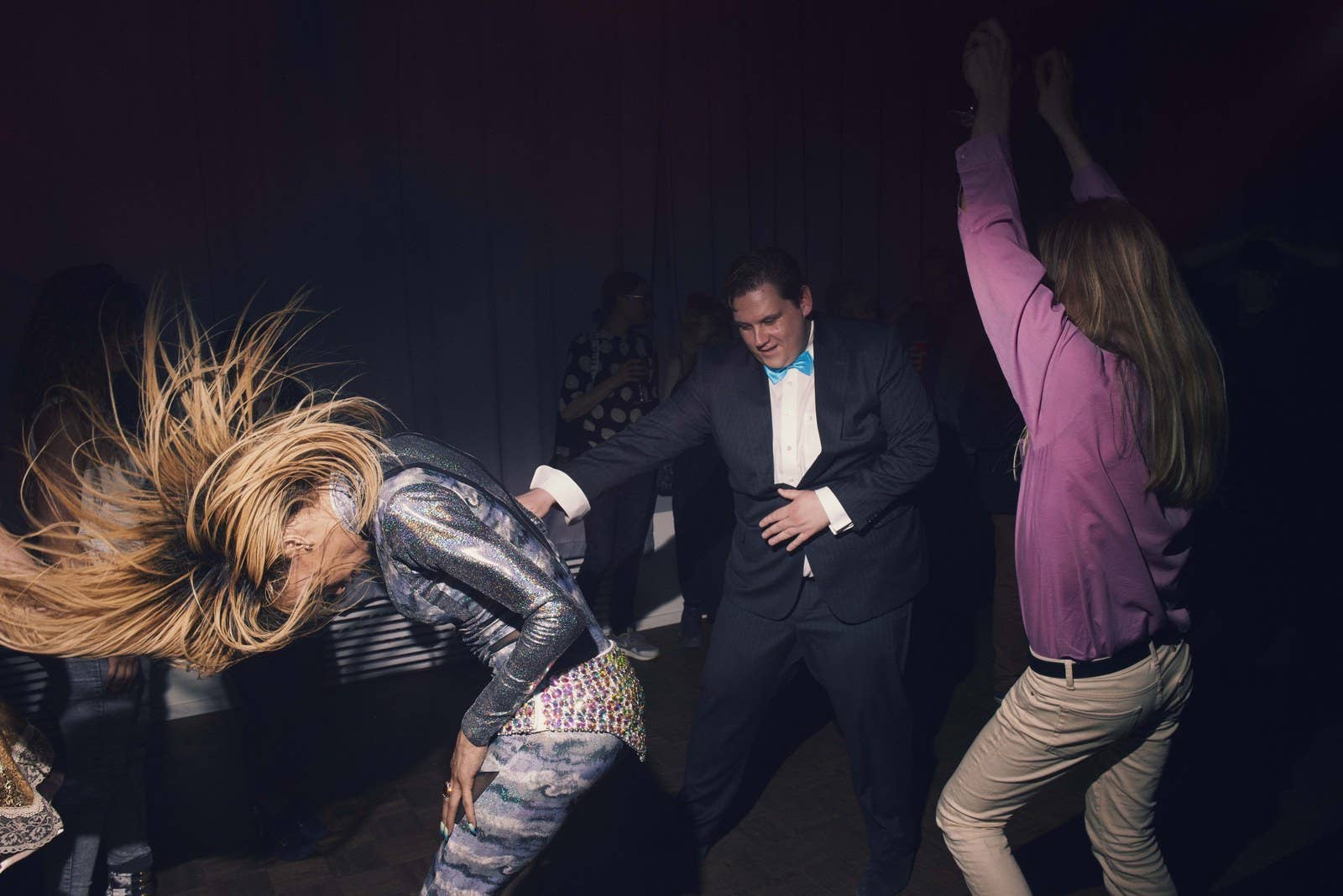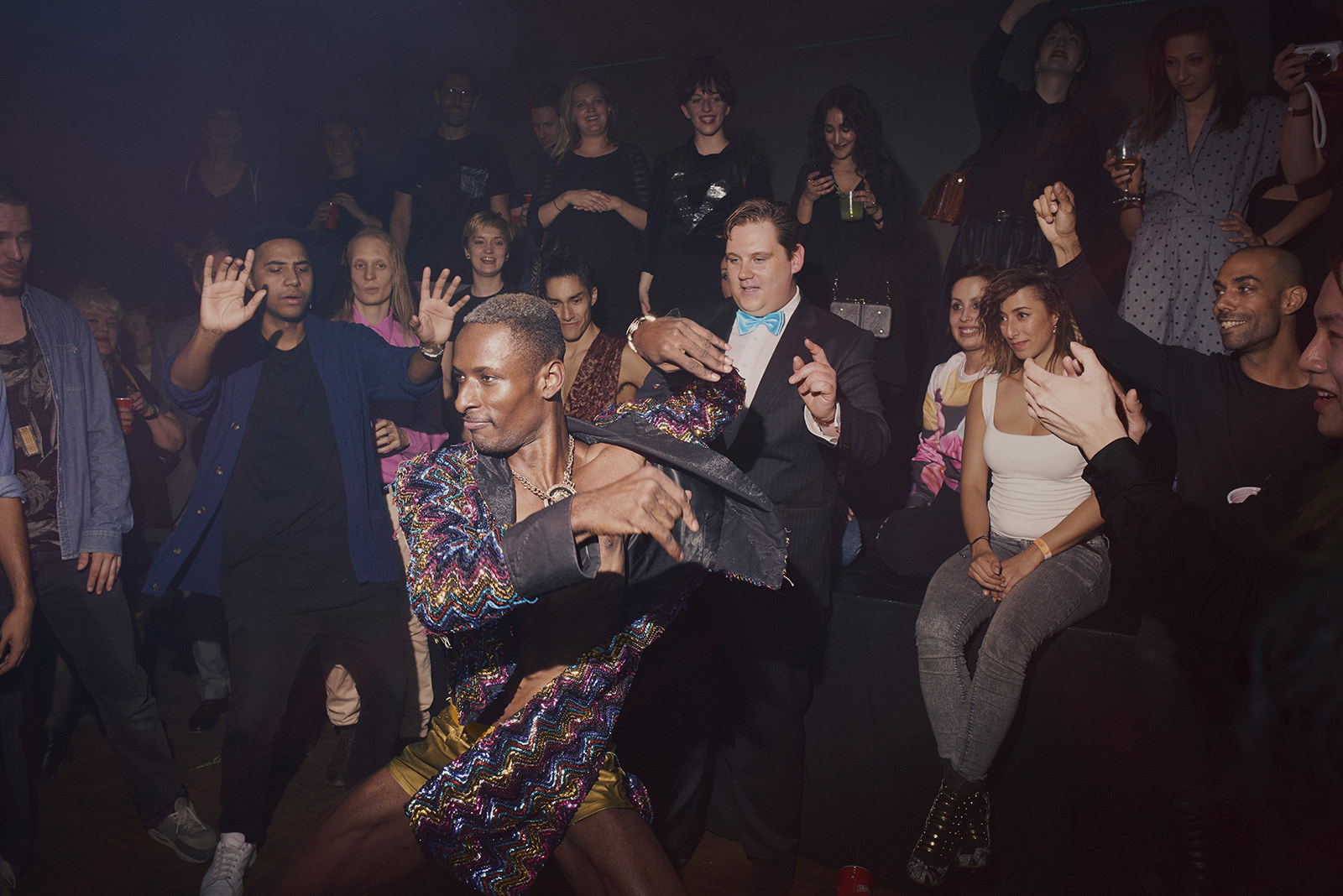
She strides along a high catwalk, bathed in crimson light, the beat driving her every movement like doof-doof-doof. She drops to all fours, spinning on her knees in a fluid rhythm as the MC talks energetically over her, punctuating the soundtrack like percussion – "Play! Play! Play! Play!"
Leiomy Maldonado – stunning, snakeskin catsuit, leather heels – has the complete attention of every single person in the place. She whips her long blonde hair like a flaxen blur as she picks herself up from the floor before throwing herself back down again in dramatic collapse. She is slaying it.
"Voguing is taking the music and presenting your story." —Dashaun
It began in Harlem, New York – as a lot of things did.
Harlem's new Renaissance, some 40 years after the North Manhattan neighborhood's original cultural surge brought disenfranchised black voices unprecedented recognition, sought to bring the city's burgeoning young black, Latino, and LGBT communities to the fore.
Long marginalized in the city, these once disparate groups found a place of safety and solidarity where they could thrive. Taking more than a little influence from the black drag queen events of the 1960s, ballroom culture – the competitive walking, dancing, and straight-up strutting events held in Harlem's old school, packed-to-the-rafters music halls – was vital for a community in danger from society and from themselves. It was a source of empowerment for the powerless.
The New York of the '80s was a totally different city than now. Crime rates spiraled, countless lived below the bread line, and, towards the end of the decade, the AIDS epidemic turned families against each other. Thousands of young LGBT people were left out on the street, forced to fend for themselves in a culture that seemed to despise and dehumanize them. That's where the balls came in.
Immortalised in Jennie Livingston's iconic documentary Paris Is Burning, ballroom culture turned these people into the stars they longed to be and brought them a sense of belonging in new "families", referred to as "houses", inspired by the fashion houses that were so influential to the scene. Each house had a leader after which the house was usually named. Xtravaganza, Ninja, LaBeija, St. Laurent – houses like these were a sanctuary for hundreds brought together by sexuality, circumstance, and the amazing ability to dance.
While the tale of the patrons and performers is punctuated by tragedy, the community thrived as the media took hold of the idea, helping raise many members out of poverty and raise millions of dollars for LGBT charities. It helped humanize them, challenged the sexual subjectivity of America's media, and turned one of its staples, voguing, into a true American art form.
It was everywhere, this rhythmic shape cutting and posing. It summed up a decade obsessed with iconography and celebrity in a way that was accessible and fun. Everyone could vogue, and that was partly the point of its popularity in the original balls; you could be tiny or you could be 300 pounds – all of you could do it. Some took it to extremes. There were awards given out for the best, after all, but everyone struck a pose.
These things are cyclical (all the best things are), and after a spell of dormancy, voguing has returned to the mainstream, helped by New York's swelling LGBT rap scene (aided in no small part by rapper and Harlem's own Azealia Banks), the internet, and a generation that is becoming more active and positively effective on the community by the day.
One of the performers at the forefront is Leiomy Maldonado, a 28-year-old transgender New York native of Puerto Rican heritage.
"I believe voguing is still important to the scene because it's still an outlet for self expression and emotion," she says. "Now that it's become a dance style inspiring many around the world, the LGBT community is being recognized for something positive."
Her rise to fame has been near unprecedented. Not since the scene's godfather, Willi Ninja, donned the shapes in Malcolm McLaren's "Deep in Vogue" and inspired Madonna has one of its stars shone so brightly. From starting to vogue at 16 years old to her star-making turn as the life force of Vogue Evolution on American show America's Best Dance Crew, Leiomy has now featured in music videos with the likes of Willow Smith and inspired everyone from Beyoncé to Britney with her signature move, the Leiomy Lolly.
An exponent of the Vogue Fem scene's Dramatics, Leiomy's style is raw, brash, and vibrant, with an emphasis on tricks and speed. Seeing her Lolly at full speed reveals it as a breathtaking move of controlled aggression, and it's no wonder why it's been so instantly iconic.
Despite her success, she's quick to thank the original Harlem scene's influence, and her story echoes those of many people featured in the early days of vogue.
"Growing up, I didn't have much support from family and some of my peers," she says. "However, it was that rejection, so to speak, that pushed me to greatness. My determination and success has earned the respect and support of my family and friends."

It's a tale as old as time: adversity driving someone towards success. But, hopefully, the success of transgender performers in the mainstream will lead to less stories like Leiomy's and towards a day when success can just mean acceptance.
It's not just in New York that things are taking off. "The best thing about the ballroom scene right now is the fact that it has reached Europe and it's becoming an international movement," she says. "I think that is amazing."
One such international performer is Bianca Traum, a 30-year-old Romanian-born woman from Stockholm. A relative newcomer to dance, Bianca has dedicated her life to dance since the age of 20 and first got into voguing in 2007 while living in New York.
"It's a part of me now," says Bianca. "Vogue allows me to sometimes get away from reality and pushes me to be better and stronger in everything that I do. It's empowered me in many ways. Vogue has made me get in touch with my femininity in ways I could never have been able to do in a world where masculinity is considerably more powerful. It's taught me the freedom of being who I want to be for that exact moment."
With the LGBT community of Stockholm somewhat removed from ballroom right now, Traum is aiming to spread the word with the help of her dance crew P*fect.
"There are, of course, people involved, but it would be nice to see it grow even more in those scenes in Sweden," she says. "I mean, if you don't agree with the LGBT point of view, then it's kind of hard to be a part of the ballroom culture."
It's this aspect of a "safe place" for society's most marginalized that was so important in the scene's early beginnings nearly 30 years ago.
An important voice in modern ballroom is Dashaun Wesley – a 30-year-old runway MC, dancer, actor, and LGBT activist from Los Angeles.
"Voguing is very important to me," he says. "It's my way of expressing my inner thoughts. It allows me to share my experiences to others through dance, and without voguing, I am not sure what direction in life I would be experiencing... But with this style I have created and seen a world of greatness."
Me, me, me. I, I, I. It's community and it's about bringing people together, but it's also a celebration of individuality and self-confidence – something nobody can doubt if they've seen a runway in the flesh.
"Balls, nowadays, are still judged and structured the same since the beginning, but the theatrics of it raises the bar," adds Dashaun. "[It] is like a rush of 'OMG OMG OMG! Did you see that?!'"
While some have criticized the competitive aspect of ballrooms ("Although balls can be fun and full of energy, competition and anxiousness can sometimes set a negative mood," says Leiomy, a seasoned pro of many a walk), it's clearly something that ingratiates itself with many performers.
"Even though, at times, there is shade involved, I still think that the different energies and personalities combined makes the culture to something very special. A ball is always a competition where you represent your house, so it's a large responsibility and a huge honor, and that's why you have to be on point," says Bianca. "If you walk, you better bring it."
As the voguing scene embeds itself into the worldwide popular consciousness once more, perhaps it's time we all took to the runway together and slayed it.
Have fun, express yourself, and drink Smirnoff responsibly.
Please do not share with anyone under the age of 18.
All images courtesy of Smirnoff UK.

